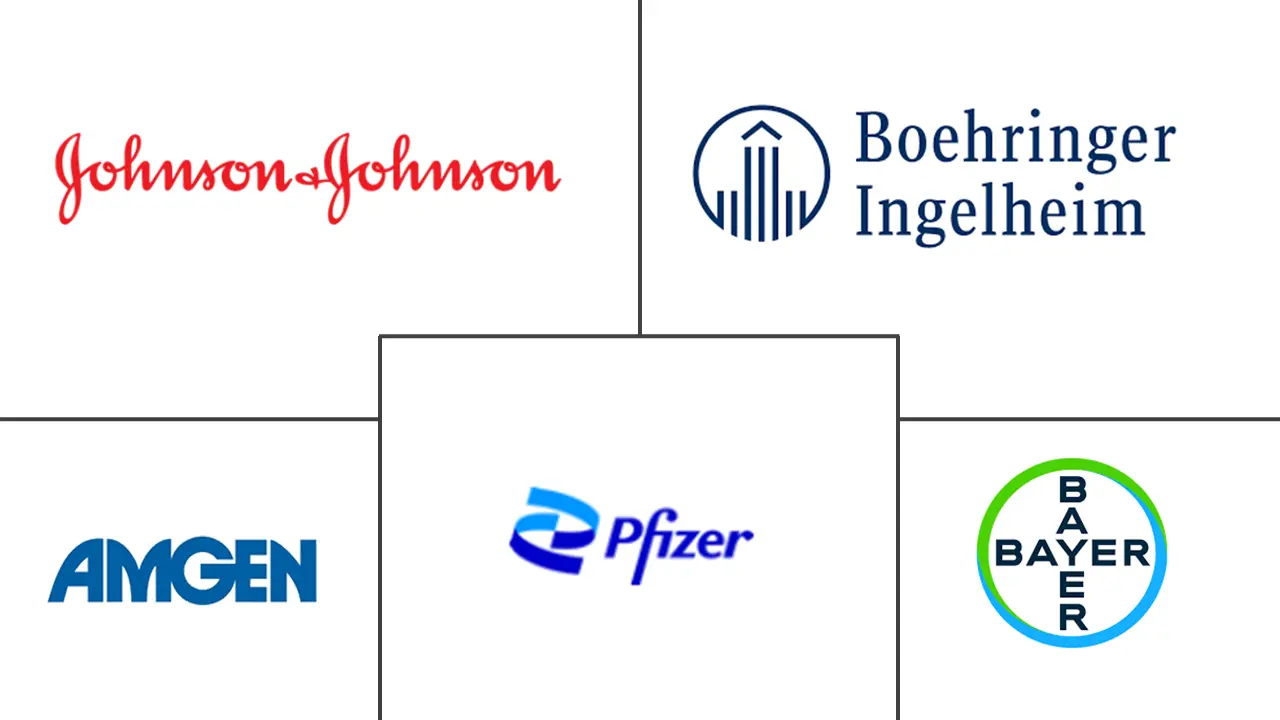Peptide And Anticoagulant Drugs Market Size and Share
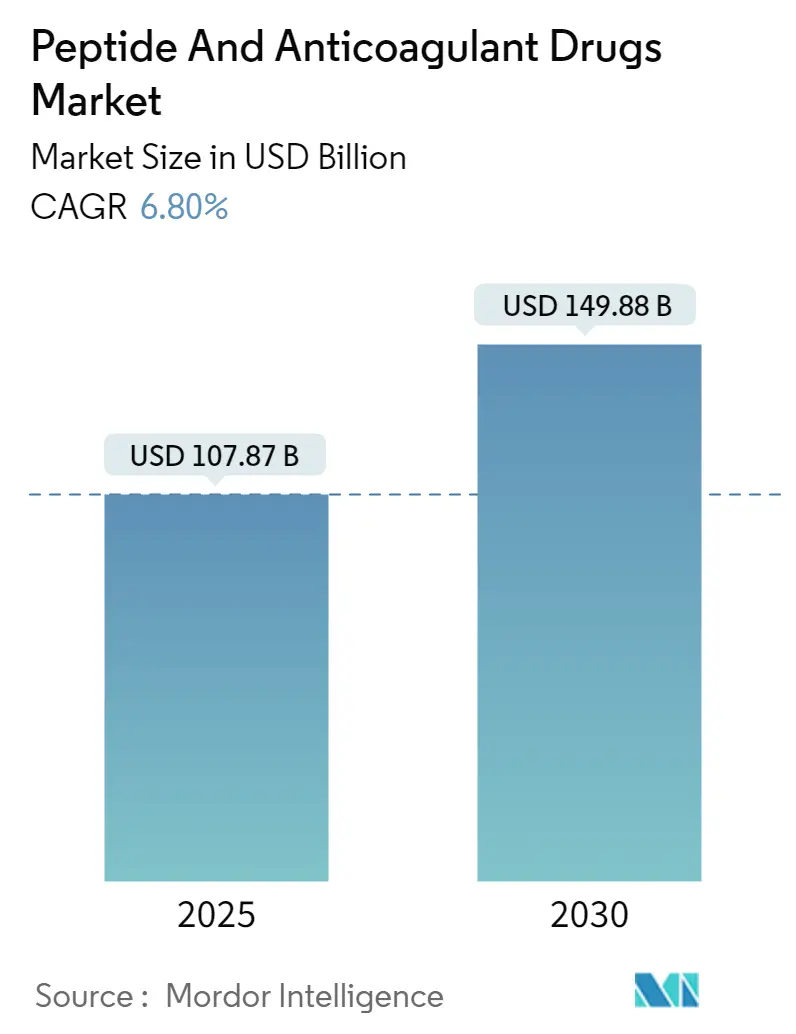
Peptide And Anticoagulant Drugs Market Analysis by Mordor Intelligence
The Peptide And Anticoagulant Drugs Market size is estimated at USD 107.87 billion in 2025, and is expected to reach USD 149.88 billion by 2030, at a CAGR of 6.8% during the forecast period (2025-2030).
Various factors, such as the increasing prevalence of cancer and metabolic disorders, rising investments in the R&D of novel drugs, and technological advancements in drug development, are expected to enhance the market's growth.
The rising prevalence of cancer and other metabolic disorders is a significant factor driving the market's growth. For instance, according to the data updated by the Glocal Cancer Observatory (GLOBOCON) in February 2024, cancer cases were expected to rise from 4.82 million in 2022 to 5.72 million in 2030. Additionally, the prevalence of cancer is anticipated to reach 1.06 million in 2030, which is an increase from 1.01 million in 2022 in Japan. Thus, the greater prevalence of cancers has increased the demand for various peptide drugs to treat these diseases.
The rising R&D for novel drugs is also expected to boost market growth. For instance, according to the European Federation of Pharmaceutical Industries and Associations (EFPIA’s) Annual Report 2022, the research-based pharma industry invested USD 51.55 million (GBP 41.5 billion) in European research and development activities. Additionally, as per the report published in April 2022 by Biocon Biologics Limited, a subsidiary of biopharmaceutical market player Biocon, research and development expenses were increased by 187% to USD 106 million in 2023 (USD 37.2 million in 2022). Thus, the increase in research and development expenses is expected to promote the research activities for developing novel drugs, including peptide and anticoagulant drugs, driving the market growth.
The rising developments by major market players are also expected to enhance market growth. In November 2023, the American Heart Association reported that the investigational anti-clotting drug abelacimab effectively reduced bleeding among patients with atrial fibrillation. Additionally, in October 2022, Tiefeenbacher Pharmaceuticals launched the generic version of apixaban for an early market entry in Canada. Apixaban is an oral anticoagulant (blood thinner) indicated for preventing venous thromboembolism (VTE) in adult patients. Thus, such developments are expected to boost the adoption of peptide and anticoagulant drugs, contributing to market growth.
Thus, factors such as the increasing prevalence of cancer and metabolic disorders, rising investments in the R&D of novel drugs, and technological advancements in drug development are expected to enhance the market's growth. However, the high cost of developing medicines and stringent government regulations are expected to hinder this growth.
Global Peptide And Anticoagulant Drugs Market Trends and Insights
The Cancer Segment is Expected to Hold a Significant Market Share During the Forecast Period
Cancer is a disease in which some of the body's cells grow uncontrollably and spread to other parts. The increasing prevalence of cancer worldwide and the rising R&D for better oncology drugs are the major factors expected to boost segmental growth during the forecast period.
For instance, according to a report published by PubMed Central in March 2022, 274,488 new cancer cases and 81,277 cancer deaths were expected in South Korea in 2022. The most common cancer types were expected to be thyroid cancer, lung cancer, colon and rectum cancer, breast cancer, and stomach cancer. These five types of cancer are expected to represent half of the overall burden of cancer in South Korea. The most common type of cancer leading to death is expected to be lung cancer, followed by liver, colorectal, pancreatic, and gallbladder cancers. Thus, the rising prevalence of cancer is expected to boost the usage of peptide drugs.
According to the bi-annual report published by the Indian Council of Medical Research (ICMR) in December 2022, the average of cancer cases in 2022 in India was 100.4 per 100,000, with a large number of women (an estimated 105.4 per 100,000) being diagnosed with breast cancer. The source also stated an estimated 182,000 people are living with breast cancer in India, which is expected to reach 250,000 by 2030. Thus, due to the country's high burden of breast cancer, the demand for peptide drugs is expected to increase, which will drive the growth of the market.
According to the data published by the National Institutes of Health (NIH) in May 2022, research funding for cancer in the United States was expected to increase from USD 7,362 million in 2021 to USD 7,644 million in 2022. Thus, the rising R&D expenses for cancer are expected to boost segmental growth.
Hence, factors such as the rising prevalence of cancer and the growing R&D expenses for cancer are expected to drive the segment during the forecast period.
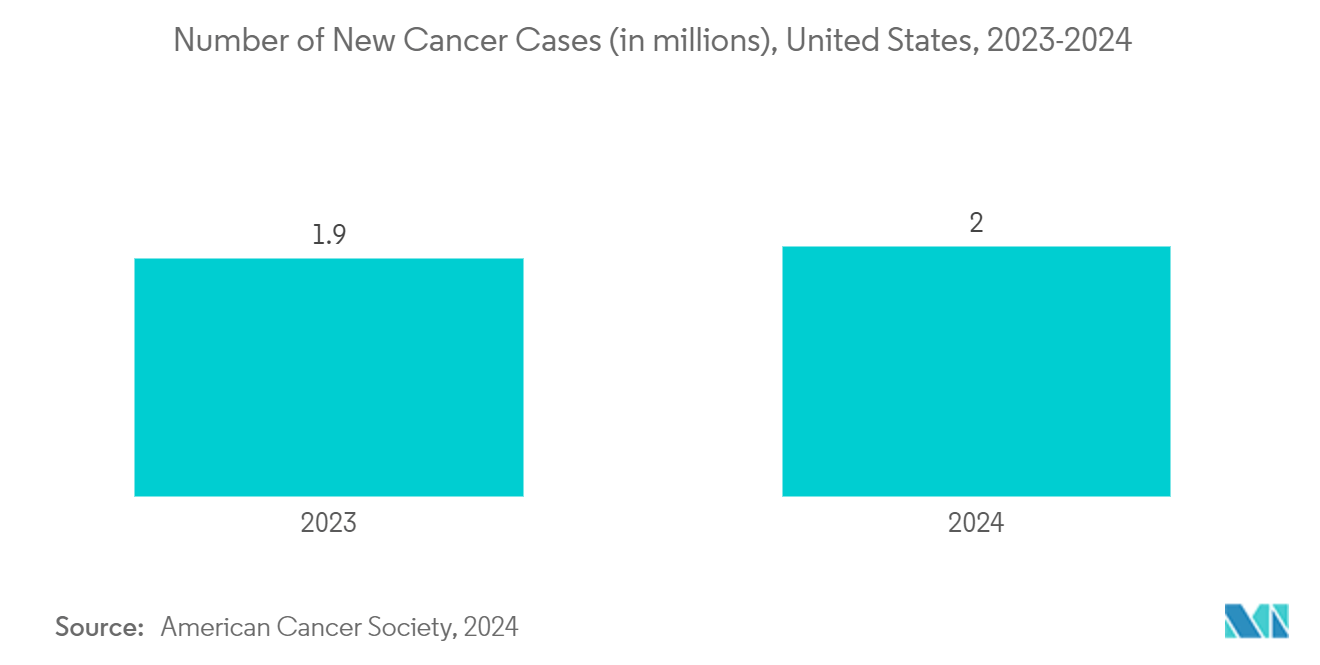
North America is Expected to Hold a Significant Market Share During the Forecast Period
North America is expected to hold a significant share of the peptide and anticoagulant drugs market during the forecast period due to the increasing necessity of drugs for cancer, the increasing prevalence of cardiovascular disorders and other diseases, and the high demand for peptide and anticoagulant drugs. The United States holds the largest market share in North America due to factors such as the increasing burden of cancer and the growing prevalence of cardiovascular disorders, which is anticipated to stimulate the demand for peptide and anticoagulant drugs.
The region's rising prevalence of various cancers stimulates the market's growth. For instance, as per the Canada Cancer Society's statistics for 2024, around 247,000 Canadians are expected to be diagnosed with cancer in 2024. Additionally, as per the American Cancer Society's data for 2024, around 2.0 million new cancer cases are expected to be diagnosed in the United States in 2024, an increase of 1.9 million in 2023. Thus, the high incidence of cancer cases leads to increased demand for peptide drugs, thereby driving the market in the region.
According to an article published by the Heart and Stroke Foundation of Canada in February 2022, in Canada, 750,000 people lived with heart failure in 2022, and 100,000 people are diagnosed with this incurable condition each year. Thus, the country's high cardiovascular disease burden is expected to increase the demand for anticoagulant drugs, thus boosting the market's growth.
The rising developments by major market players are also expected to drive the market. For instance, in February 2022, Bayer AG won fast-track status from the United States Food and Drug Administration (FDA) for a new blood thinner to prevent certain types of strokes. The FDA granted fast-track designation for the review of the drug candidate asundexian for avoiding a recurrence in patients who have suffered a non-cardioembolic stroke due to clogged vessels. Thus, such developments are expected to contribute to the market growth.
Thus, factors such as the rising prevalence of cancer and other metabolic disorders and the increasing developments by key market players are expected to drive the market in the region.
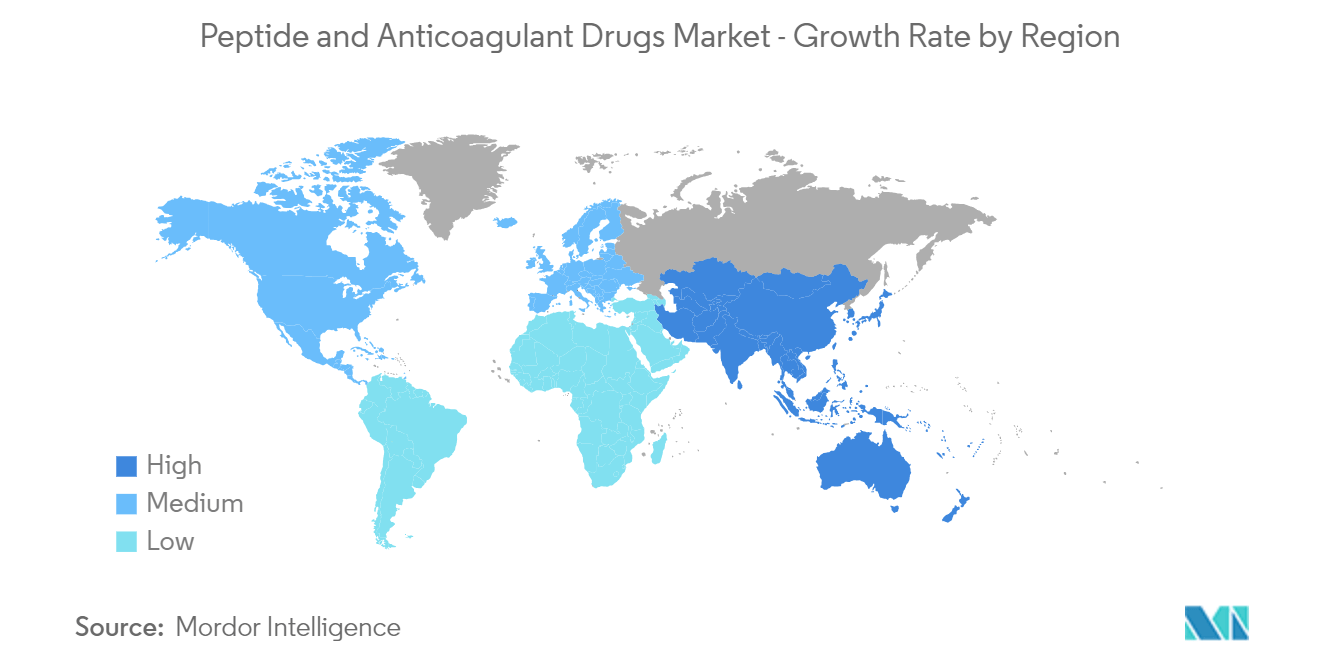
Competitive Landscape
The peptide and anticoagulant drugs market is highly competitive and has several major players. Some companies dominating the market are Amgen Inc., Bayer AG, Boehringer Ingelheim International GmbH, Bristol-Myers Squibb Company, Daiichi Sankyo Company, EVER Pharma, Johnson & Johnson, Pfizer Inc., Sanofi, Novartis AG, and Novo Nordisk AS.
Peptide And Anticoagulant Drugs Industry Leaders
-
Amgen Inc.
-
Bayer AG
-
Boehringer Ingelheim International GmbH
-
Johnson & Johnson
-
Pfizer Inc.
- *Disclaimer: Major Players sorted in no particular order
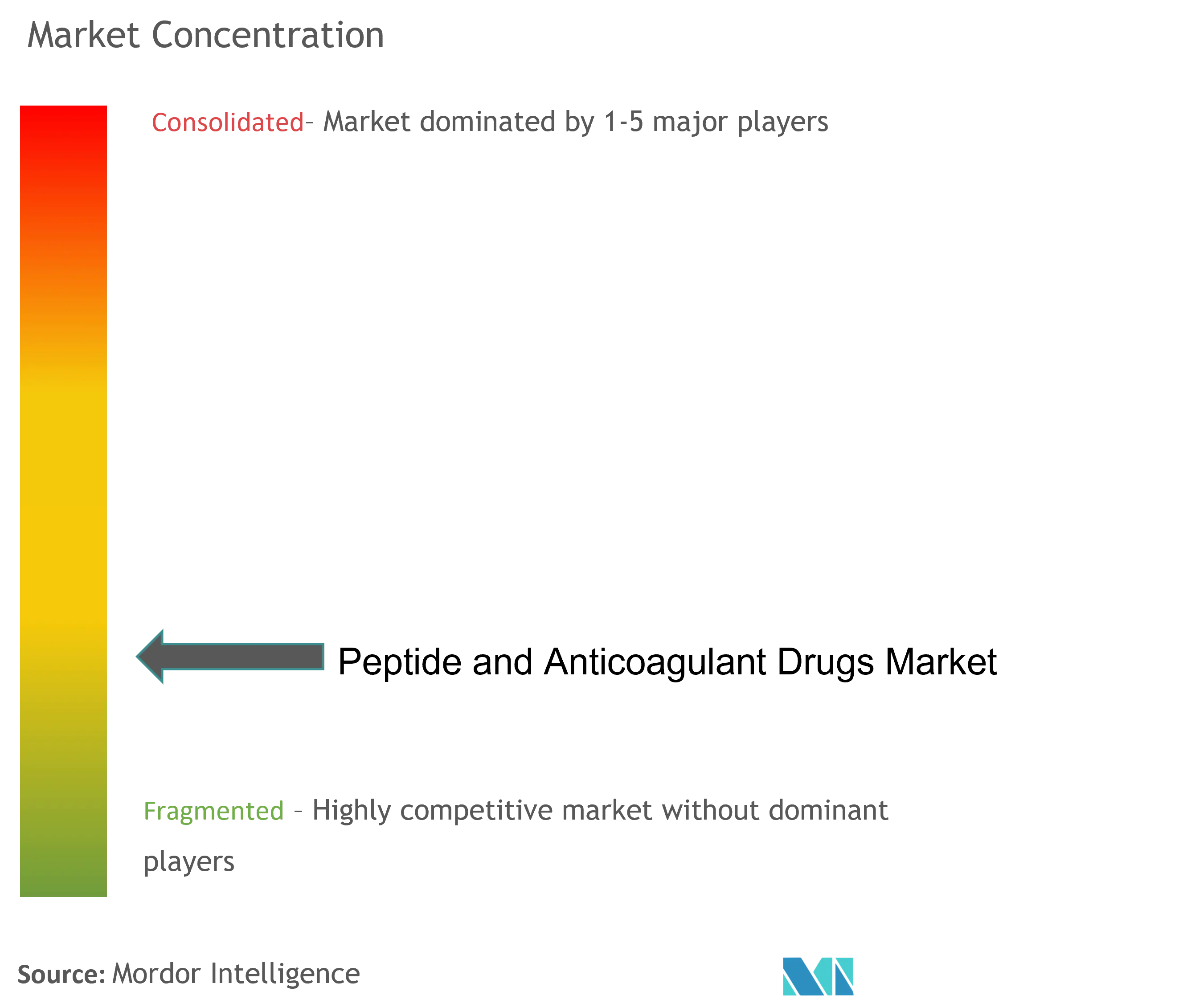
Recent Industry Developments
- April 2024: Cadrenal Therapeutics Inc. received approval from the United States Food and Drug Administration to develop the oral and reversible anticoagulant tecarfarin, which can reduce blood clotting caused by heart attacks, strokes, and other heart disorders.
- February 2024: The Orbis Medicine startup was launched with an investment of USD 28 million to develop peptide drugs that can be consumed through oral administration.
Global Peptide And Anticoagulant Drugs Market Report Scope
Anticoagulants, commonly known as blood thinners, are used to block and treat blood clots in blood vessels and the heart, which can cause severe complications as the clot disrupts blood flow to essential organs and can result in heart attack and stroke. Peptides are long-chain amino acids held together by peptide bonds, also called amide bonds.
The peptide and anticoagulant drugs market is segmented by route of administration, application, and geography. The market is further segmented by route of administration into peptide and anticoagulant drugs. By peptide drugs, the market is sub-segmented into parenteral, oral, mucosal, and other routes of administration. With anticoagulant drugs, the market is sub-segmented into oral and injectable. The peptides drug segment is segmented into gastrointestinal disorders, cardiovascular disorders, neurological disorders, metabolic disorders, cancer, and other applications. The market is sub-segmented by anticoagulant drugs into atrial fibrillation and heart attack, stroke, deep vein thrombosis (DVT), pulmonary embolism (PE), and other applications. By geography, the market is segmented into North America, Europe, Asia-Pacific, the Middle East and Africa, and South America. For each segment, the market size is provided in terms of USD value.
| Peptide Drugs | Parenteral |
| Oral | |
| Mucosal | |
| Other Routes of Administration | |
| Anticoagulant Drugs | Oral |
| Injectable |
| Peptide Drugs | Gastrointestinal Disorders |
| Neurological Disorders | |
| Metabolic Disorders | |
| Cancer | |
| Other Applications | |
| Anticoagulant Drugs | Atrial Fibrillation and Heart Attack |
| Stroke | |
| Deep Vein Thrombosis (DVT) | |
| Pulmonary Embolism (PE) | |
| Other Applications |
| North America | United States |
| Canada | |
| Mexico | |
| Europe | Germany |
| United Kingdom | |
| France | |
| Italy | |
| Spain | |
| Rest of Europe | |
| Asia-Pacific | China |
| Japan | |
| India | |
| Australia | |
| South Korea | |
| Rest of Asia-Pacific | |
| Middle East and Africa | GCC |
| South Africa | |
| Rest of Middle East and Africa | |
| South America | Brazil |
| Argentina | |
| Rest of South America |
| By Route of Administration | Peptide Drugs | Parenteral |
| Oral | ||
| Mucosal | ||
| Other Routes of Administration | ||
| Anticoagulant Drugs | Oral | |
| Injectable | ||
| By Application | Peptide Drugs | Gastrointestinal Disorders |
| Neurological Disorders | ||
| Metabolic Disorders | ||
| Cancer | ||
| Other Applications | ||
| Anticoagulant Drugs | Atrial Fibrillation and Heart Attack | |
| Stroke | ||
| Deep Vein Thrombosis (DVT) | ||
| Pulmonary Embolism (PE) | ||
| Other Applications | ||
| By Geography | North America | United States |
| Canada | ||
| Mexico | ||
| Europe | Germany | |
| United Kingdom | ||
| France | ||
| Italy | ||
| Spain | ||
| Rest of Europe | ||
| Asia-Pacific | China | |
| Japan | ||
| India | ||
| Australia | ||
| South Korea | ||
| Rest of Asia-Pacific | ||
| Middle East and Africa | GCC | |
| South Africa | ||
| Rest of Middle East and Africa | ||
| South America | Brazil | |
| Argentina | ||
| Rest of South America | ||
Key Questions Answered in the Report
How big is the Peptide And Anticoagulant Drugs Market?
The Peptide And Anticoagulant Drugs Market size is expected to reach USD 107.87 billion in 2025 and grow at a CAGR of 6.80% to reach USD 149.88 billion by 2030.
What is the current Peptide And Anticoagulant Drugs Market size?
In 2025, the Peptide And Anticoagulant Drugs Market size is expected to reach USD 107.87 billion.
Who are the key players in Peptide And Anticoagulant Drugs Market?
Amgen Inc., Bayer AG, Boehringer Ingelheim International GmbH, Johnson & Johnson and Pfizer Inc. are the major companies operating in the Peptide And Anticoagulant Drugs Market.
Which is the fastest growing region in Peptide And Anticoagulant Drugs Market?
Asia-Pacific is estimated to grow at the highest CAGR over the forecast period (2025-2030).
Which region has the biggest share in Peptide And Anticoagulant Drugs Market?
In 2025, the North America accounts for the largest market share in Peptide And Anticoagulant Drugs Market.
What years does this Peptide And Anticoagulant Drugs Market cover, and what was the market size in 2024?
In 2024, the Peptide And Anticoagulant Drugs Market size was estimated at USD 100.53 billion. The report covers the Peptide And Anticoagulant Drugs Market historical market size for years: 2019, 2020, 2021, 2022, 2023 and 2024. The report also forecasts the Peptide And Anticoagulant Drugs Market size for years: 2025, 2026, 2027, 2028, 2029 and 2030.
Page last updated on:
Peptide And Anticoagulant Drugs Market Report
Statistics for the 2025 Peptide And Anticoagulant Drugs market share, size and revenue growth rate, created by Mordor Intelligence™ Industry Reports. Peptide And Anticoagulant Drugs analysis includes a market forecast outlook for 2025 to 2030 and historical overview. Get a sample of this industry analysis as a free report PDF download.
